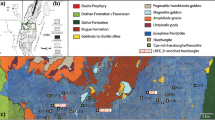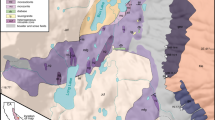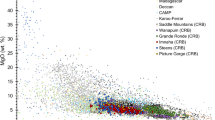Abstract
It is well established that porous melt flow in the upper mantle may significantly affect partial mantle melt compositions. Less well established are the length-scale of porous flow and whether porous melt flow can be a volumetrically important magmatic process. The only source for observations concerning the length-scale and nature of pervasive porous melt flow are peridotite massifs. Here we present such observations in the form of structural, and major and trace element data from peridotites of the Ronda massif, southern Spain. Trace element concentrations were obtained with high analytical precision (ICP-MS) and include trace elements rarely analysed in peridotites, such as Rb, Th, Nb and Ta. The western portion of the Ronda massif can be divided into two structural facies. The first and oldest is composed of deformed, porphyroclastic spinel peridotites, the second of virtually undeformed granular spinel peridotites. They are separated by a recrystallisation front across which grain growth of all phases occurred. The granular domain can be further subdivided into three subfacies: coarse-granular, fine-granular, and layered-granular peridotites. According to structural facies, km-scale spatial variations unrelated to Ca and Al abundances have been recognised for mg-numbers [atomic Mg/(Mg±Fe)] and incompatible elements such as rare earth elements (REE), Th and high-field-strength elements (HFSE; including Ti). Such variations are reminiscent of those commonly ascribed to mantle metasomatism, but have never been documented on the km-scale. The origin of the recrystallisation front is related to km-scale pervasive melt percolation. Feed-back processes between grain growth and melt fraction could have led to important accumulation of melt at the recrystallisation front, accomplished mainly by melting/dissolution. Variation in melt fraction across the front explains the spatial variation in the degree of recrystallisation, mg-numbers, REE fractionation, and HFSE abundances, and could account for many of the classical differences between basalts from convergent and extensional tectonic settings. Whereas the coarse-granular peridotites reflect a stage of steady-state pervasive porous melt flow, the fine- and layered-granular facies probably reflect the terminate stages of porous melt flow. Processes associated with both domains are pyroxene-forming freezing reactions at decreasing melt volumes, and progressive channelling of melt flow associated with olivine-producing reactions. Both processes show complex overprinting relationships in both time and space.
Similar content being viewed by others
Author information
Authors and Affiliations
Additional information
Received: 10 January 1995/Accepted: 1 September 1995
Rights and permissions
About this article
Cite this article
der Wal, D., Bodinier, JL. Origin of the recrystallisation front in the Ronda peridotite by km-scale pervasive porous melt flow. Contrib Mineral Petrol 122, 387–405 (1996). https://doi.org/10.1007/s004100050135
Issue Date:
DOI: https://doi.org/10.1007/s004100050135




